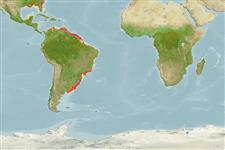Elasmobranchii (haaien en roggen) (sharks and rays) >
Myliobatiformes (Stingrays) >
Myliobatidae (Eagle and manta rays)
Etymology: Myliobatis: Greek, mylo = mill + Greek, + Greek, batis,-idos = a ray (Raja sp.) (Ref. 45335).
Eponymy: Dr George Brown Goode (1851–1896) was an American ichthyologist and museum administrator at the Smithsonian. [...] (Ref. 128868), visit book page.
More on author: Garman.
Environment: milieu / climate zone / depth range / distribution range
Ecologie
marien benthopelagisch; diepte 1 - 130 m (Ref. 57911). Tropical; 33°N - 40°S, 180°W - 180°E
Worldwide in tropical waters. Western Atlantic: South Carolina, USA to Argentina. Often confused with Myliobatis freminvillii.
Grootte / Gewicht / Leeftijd
Maturity: Lm ? range ? - ? cm
Max length : 125 cm TL mannelijk / geslacht onbekend; (Ref. 57911); common length : 80.0 cm WD mannelijk / geslacht onbekend; (Ref. 6077)
Smaller dorsal fin set farther back on tail, well beyond the pelvic fins. Disk broader, with more rounded corners of wings. Snout less projecting. No spines on disk (Ref. 7251). Broader separation between the inner ends of gill openings. Chocolate or greyish brown above and brownish white below (Ref. 6902).
Ovoviviparous (Ref. 50449). In coastal waters down to 130 m.
Levenscyclus en paargedrag
Maturiteit | Voortplanting | Paaien | Eieren | Fecunditeit | Larven
Exhibit ovoviparity (aplacental viviparity), with embryos feeding initially on yolk, then receiving additional nourishment from the mother by indirect absorption of uterine fluid enriched with mucus, fat or protein through specialised structures (Ref. 50449).
Robins, C.R. and G.C. Ray, 1986. A field guide to Atlantic coast fishes of North America. Houghton Mifflin Company, Boston, U.S.A. 354 p. (Ref. 7251)
Status op de Rode Lijst van het IUCN (Ref. 130435: Version 2024-1)
Gevaar voor de mens
Harmless
Gebruik door de mens
Visserij: van minder commercieel belang
Tools
Speciale rapporten
Download XML
Internetbronnen
Estimates based on models
Preferred temperature (Ref.
123201): 13.3 - 27.8, mean 24.4 °C (based on 732 cells).
Fylogenetische diversiteitsindex (Ref.
82804): PD
50 = 0.5002 [Uniqueness, from 0.5 = low to 2.0 = high].
Bayesian length-weight: a=0.00389 (0.00119 - 0.01269), b=3.08 (2.83 - 3.33), in cm total length, based on LWR estimates for this (Sub)family-body shape (Ref.
93245).
Trofisch niveau (Ref.
69278): 3.3 ±0.34 se; based on food items.
Weerstandsvermogen (Ref.
120179): Zeer laag, minimale populatieverdubbelingstijd meer dan 14 jaar (Fec assumed to be <10).
Fishing Vulnerability (Ref.
59153): High to very high vulnerability (75 of 100).
Nutrients (Ref.
124155): Calcium = 22.5 [6.6, 112.7] mg/100g; Iron = 0.637 [0.161, 1.754] mg/100g; Protein = 20.6 [15.6, 25.8] %; Omega3 = 0.153 [0.043, 0.476] g/100g; Selenium = 61.5 [15.7, 183.1] μg/100g; VitaminA = 14.3 [5.5, 36.8] μg/100g; Zinc = 0.875 [0.426, 1.585] mg/100g (wet weight);
